A study in six sections by Nigel Harris about the owners of sailing trows and barges that used the Stroudwater Canal and traded to places on the lower River Severn and the Bristol Channel.
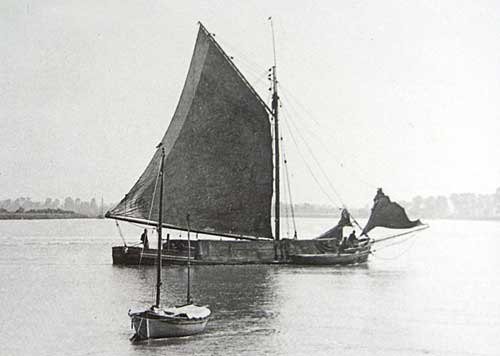

This study is largely based on contemporary newspaper reports together with details of vessel ownership and activity recorded in the Gloucester Shipping Registers and Crew Lists (D4292 and D3080). Those barges that only traded to Lydney and Bullo Pill, within the limits of the Port of Gloucester, are mentioned but have not been studied individually as details of their ownership did not have to be registered.
The Stroudwater Canal was built to suit the existing trows and barges that traded on the River Severn in the 1770s, and many of the early vessels using the canal were owned at places up and down the river. However, local men also joined in, and it was not long before they dominated the trade, many using barges built at the Bourne yard near Brimscombe.
Some owners worked as master of their own vessel carrying cargoes for merchants, some traded primarily as a coal merchant using one or more barges to bring coal to his canal-side wharf or to local businesses, and others were corn merchants who used their own barges to bring wheat to a mill and to take flour away.
By Nigel Harris
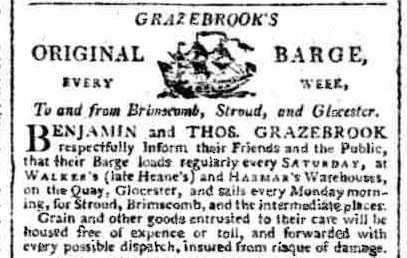

Entrepreneurial contractor Benjamin Grazebrook had promoted the building of the Stroudwater Canal, and along with his sons Joseph and Thomas had profited from their construction. As well as being one of the Stroudwater Canal’s proprietors, Grazebrook senior held several positions within the company during the canal’s construction, during which time he began operating barges from Dudbridge. Shortly after the canal was completed, in association with his son Thomas, Grazebrook established market boats running between Wallbridge, Gloucester and Bristol. Meanwhile, his son Joseph became the clerk and later treasurer of the Stroudwater Company. When the opportunity arose, the Grazebrooks began running their vessels on to Brimscombe, where they were met by the barges of Bowley and Tovey (who operated between Brimscombe and Cirencester) and by those belonging to John Walker (who operated on the upper Thames). In order to cope with their hoped for increased share of the Bristol trade, Benjamin Grazebrook took over a trow being built by the Thames & Severn Canal Company, and naming her Stroud Galley, put her into the Bristol trade running in tandem with his existing vessel. Continuing the family business, Thomas Grazebrook later went into partnership with Roff Newman, who had previously been operating a trow on spring tides to Bristol and a weekly barge between Stroud and Gloucester. In 1809, The Grazebrook/Newman partnership was dissolved when, by mutual consent, Thomas Grazebrook withdrew. Newman then entered into a partnership with Edward Heane of Gloucester. The firm of Heane and Newman continued in the Bristol trade for several years before withdrawing and concentrating on the Gloucester trade using the barge Nancy, master John Knight.
In the Gloucester trade, the Grazebrooks had been in competition with Gloucester wharfinger, John Lewis. Lewis ran a weekly service between his warehouse on Gloucester Quay and Brimscombe Port with a barge that left Gloucester on Mondays and returned on Fridays. At Brimscombe, it was met by one of those owned by William Hill of Cirencester, who also provided connecting services with the trows in the Bristol packet trade, forwarding cargoes on to London and intermediate places on the river Thames.
Meanwhile, the Thames & Severn Company themselves had become the largest carrier on the two canals. For several years, the Company operated a large and diverse carrying business that connected with carriers on adjoining waterways. However, the company’s efforts to source cheaper coal in order to develop their London trade met with little success. They then began introducing a series of schooner and ketch-rigged vessels that had been built and designed at the Bourne to trade directly between Brimscombe and Newport, Monmouthshire.
Unfortunately, due to the inaccessibility of the Stroudwater Canal entrance at Framilode on smaller tides, and loading delays at Newport, the amount of trade envisaged failed to materialise and the venture was short-lived. Later, the imposition of increased tolls on the River Thames meant the high cost of transporting coal from the Forest of Dean to London via the canals was prohibitive when compared to the lower cost of sea-borne coal from Newcastle upon Tyne. The failure of the hoped for London trade caused the canal company to dispose of their vessels. In July 1802, they began to advertise their barges for purchase or hire to other carriers willing to employ them in trade on the canal, and over the next four years the company’s fleet of barges and trows was disposed of.
As the Thames & Severn Canal Company gradually disposed of its carrying business, a succession of carriers began competing with each other to take over the company’s coal trade and its market boat services; beginning in November 1802, with John Baker of Brimscombe and Richard Miller of Brimscombe. John Baker had previously operated as a private carrier between Brimscombe and Stourport before he combined his business with the firm of L & R Wyatts of Oxford to run services that connected Bristol, Gloucester and Stourport to London.
Before starting up in business on his own account in November 1802, Richard Miller had been employed by the Thames & Severn Canal Company in their Brimscombe office. He began by hiring some of the canal company’s barges to carry coal to Lechlade, and as he expanded his services, he occupied warehouses at Dudbridge, Stroud and Brimscombe. In 1806, Miller took over the Gloucester and Cirencester carrying businesses of John Lewis and William Hill. Over the next few years Richard Miller diversified. He ran passenger coaches between Stroud and London, he also had a local auctioning business and in 1818 he founded the Brimscombe Port Bank. The bank, like many others of the time, was short-lived. In 1822, it failed and along with it went most of his business ventures. He continued a reduced service in the Bristol trade using the trow Neptune, which was built in 1793 at Madeley, Salop. However, competition from Samuel Banks of Epney, and Stroud corn miller John Biddle forced Miller to withdraw, and in 1824 sell the Neptune.
By Nigel Harris
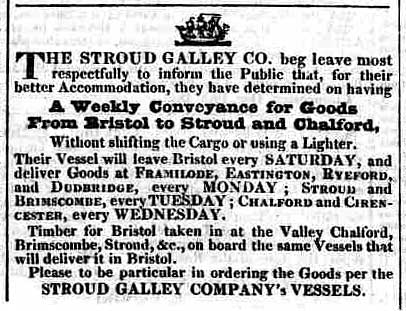

Thomas Harper of Dudbridge, in association with John Sims of Framilode, began trading between Dudbridge and Bristol in 1822, using the trow George. The following year, Sims (who had been master of the George) went into partnership with Stroud saddler Isaac Brewer and purchased the Brimscombe built trow Stroud Packet. Trading as Sims & Co, John Sims and his son Daniel sailed the Stroud Packet in the Bristol trade for a number of years. In 1846, Sims and Brewer withdrew from the Bristol trade when John Sims sold his shares in the Stroud Packet to Brimscombe coal merchant James Smith. Smith and Brewer then placed the trow in the coal trade.
Samuel Banks was an owner/master in the Bristol trade who began by operating the trow William and Mary, which he replaced in 1826 with the Galley, a trow that had been built at Brimscombe in 1802. But, competition from John Biddle who operated the Weekly Packet, and from the newly formed Stroud Galley Company put an end to Banks venture in the Bristol trade and the Galley was sold to owners at Newport, Mon, and re-registered there in 1830.
In response to competition from the Stroud Galley Company, John Biddle introduced for the first time a weekly service between Stroud and Bristol by using the newly opened Gloucester and Berkeley Canal from Saul Junction and then sailing via Sharpness (so as not to be inconvenienced at Framilode on neap tides). His vessel left Stroud on Wednesdays and returned after taking in goods at Bristol on Fridays and Saturdays. The Stroud Galley Company, which continued to use the Stroudwater Canal Framilode entrance, then responded by placing a second vessel on their service and by operating two vessels (one in each direction), doubling the number of their sailings when the tides were favourable. Biddle sold the Weekly Packet to Stroud Innkeeper James Wakefield and replaced her with the Gloster Packet, a trow built at the Bourne Yard in 1824 for William Green. Selling the Weekly Packet to James Wakefield proved to be a mistake for Biddle. Wakefield used the Weekly Packet to begin a rival service to Bristol and in 1833 he replaced the Weekly Packet with a new trow, the William. In the following year, John Biddle withdrew from the Bristol market trade and James Wakefield also purchased the Gloster Packet, which he later had partly rebuilt in 1836. Charles Bosley of Westbury on Severn was employed by Wakefield as master of his vessels in the Bristol trade. In 1838, Bosley purchased the Gloster Packet and then operated her in the Bristol trade on his own account until 1847. Later owned at Longney and Framilode, when she was rebuilt and re-rigged as a ketch, the Gloster Packet was well-known locally, trading under sail within the upper Bristol Channel until she was converted to a lighter after stranding near Burnham on Sea in 1908.
One of the promoters of the Stroud Galley Company was John George, a coal and stone merchant of Brimscombe, whose father-in-law, John Denyer, was manager of the Thames and Severn Canal. George went on to build up an extensive carrying business, rapidly becoming the principal trader and largest employer on the two canals. His vessels carried in excess of 20,000 tons of coal per annum on the Thames and Severn Canal and the upper River Thames. Besides owning a large number of barges employed in carrying coal from the Forest of Dean, George’s fleet of vessels that were registered to trade outside the limits of the port of Gloucester numbered more than thirty, as he also involved himself with the coal and iron trades of Newport and Cardiff and ventured into the coasting trades. To sustain his fleet, he leased part of the Thames and Severn Company’s yard at the Bourne, where he built and repaired vessels for himself and others.
As competition from the new railways developed, John George’s business diminished and, experiencing financial difficulties, he moved his greatly reduced concern from Brimscombe to Stonehouse. Later, accusations were made against him of systematically defrauding the canal companies over a number of years. It was alleged that George had paid the tolls of the canal companies by using forged underweight bills of lading issued by the Park End Colliery’s clerk at Lydney Docks. The claimed average annual fraud equated to one of his barges carrying around 100 tons of coal free of tolls on the canals. In 1861, John George was declared bankrupt and on 18 January 1862, his assets were sold off at auctions in Gloucester and Brimscombe.
John George was not the only trader charged with making a profit at the expense of the canal companies. William Blick of Longney was master and part owner of the barge Elizabeth (built at Bridgnorth in 1821) trading between Gloucester and Stroud. In 1846, after being found guilty of using a forged underweight receipt, Blick was sentenced to 2 years imprisonment, which was later reduced to 9 months on appeal.
By Nigel Harris
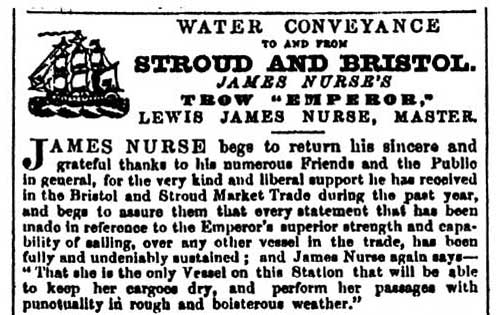

Dudbridge Wharf was a principal place of trade on the Stroudwater Canal. A number of traders occupied parts of the wharf, which served not only the adjacent canal-side communities of Dudbridge and Cainscross, but also a wide surrounding area that included parts of North Wiltshire. Prior to the construction of the Midland Railway’s branch line to the town of Nailsworth, 4 miles south of Stroud, the wharf was used to discharge cargoes consigned to the town.
Prominent amongst the vessel owners who operated from Dudbridge Wharf were Frederick, George and James Nurse of Framilode and Saul. The three brothers, along with a fourth, John, were founders of a well-known dynasty of Nurse seamen who owned coastal sailing vessels in Gloucestershire, Bristol and Bridgwater during the nineteenth and early twentieth centuries.
James Nurse had been employed as a master on barges owned by John George before becoming a coal merchant owning barges at Framilode. In 1839, he purchased the first of his barges registered to trade outside Gloucester’s port limits, the Edward (built at Bridgnorth in 1819) and three years later he acquired the Gloucester built Charlotte (dating from 1828). They were followed by three Stourport built barges; the Royal William (built in 1820), the George (built in 1827) and the Surprize (built in1844). In 1850, he entered the Bristol trade using the newly built ketch-rigged box trow, Emperor. It was claimed that due to her superior construction and sailing qualities, the Framilode built Emperor was the only vessel sailing between the Stroudwater Canal and Bristol able to keep her cargoes dry and maintain her weekly sailings in bad weather. Initially, the Emperor, sailing with James Nurse’s son Lewis as master, was such a success that the following year, James Nurse had his barge Royal William rebuilt and also put into the Bristol trade. One of them leaving Dudbridge Wharf, and the other leaving the Welsh Back, Bristol every Saturday. His venture into the Bristol trade did not last long. In 1853, he withdrew and the following year advertised the Emperor and Royal William for sale. During that time, his son Lewis sailed the Emperor in the coal trade between South Wales and ports in Cornwall until she was sold to James Tucker of Framilode in January 1855, with James Nurse providing Tucker with a mortgage to finance the transaction. As his coal business declined, James Nurse also sold off some of his other vessels.
Many people whose livelihood depended on the two canals experienced hardship as the canal coal trade went into recession. At Framilode, James Nurse kept a cottage that he used to accommodate his men employed to assist in moving and unloading his coal barges on the canal. Henry Caudle, who was employed by Nurse as a carter, was committed to the House of Correction at Horsley, near Stroud, for one month’s hard labour in 1856 for stealing a pair of Nurse’s boots. At Dudbridge in 1857, Thomas Fletcher received a similar sentence after being spotted by the canal company’s wharfinger, Joseph Cottle, using a wheel barrow belonging to James Nurse to steal a quantity of coal from Dudbridge Wharf. James Nurse’s business collapsed in 1861 and his five remaining barges were laid up at Dudbridge Wharf; where over a two day period in May, they were auctioned off along with his horses, wagons and carts, and 200 tons of coal. Having given up his tenancy on part of the wharf, James Nurse continued trading in a reduced capacity as a coal merchant in competition with Richard Williams of Saul. Williams, who had taken over Nurse’s tenancy on the wharf, also attempted to take over all of Nurse’s customers by placing misleading adverts in the local press. The proceeds of his assets sale at Dudbridge failed to halt the decline of James Nurse, and in 1866 his personal effects at Framilode were also sold off.
Wharfinger coal merchant Frederick Nurse, in association with his son Martin, also occupied part of Dudbridge Wharf. He was an avid supporter of the popular temperance movements at Dudbridge and Framilode. On Monday 26th July 1847 at Dudbridge, a crowd estimated at nearly a thousand people witnessed the launch of Frederick Nurse’s barge Ellen, built by another local temperance supporter, George Shepherd. The event was celebrated with a tea party, followed by a lively public meeting advocating the doctrine of total abstinence. At 11 a. m. on the day after her launch, she left Dudbridge carrying the Ebley Brass Band and a large party of singing supporters to witness the ceremony of laying the foundation stone of the British School at Framilode, returning to Dudbridge around midnight. The Ellen repeated the excursion on 21st December 1847 when she left Dudbridge at noon for the school’s opening ceremony at 4 30 p.m. and returned later that same evening. Known as the “teetotal barge”, the Ellen initially only traded within the limits of the Port of Gloucester, on the Stroudwater canal and the River Severn, and was not registered until November 1847, from which time she traded between Stroud and Bristol. In 1849, Frederick Nurse sold the Ellen to his brother George, who then ran her on his own account between Stroud and Bristol.
George Nurse had commenced in the Bristol market trade in 1841, using the trow Harriet, built at the Bower Yard, Salop, in 1827, of which he was master. Leaving Stroud every other Friday and arriving in Bristol on the following Wednesdays, he then returned on Saturdays and arrived back at Stroud on Tuesdays, having called at intermediate places along the canal as required. Expanding his Bristol trade, George Nurse used the Ellen as a second vessel, and on occasions also used another of his barges, the Peel (built at Brimscombe in 1848). Amongst the men he employed as masters of his vessels were two his sons, George junior and John William.
George Nurse also established himself as a coal merchant at Dudbridge, occupying part of the wharf and renting a house, office and stables from the Stroudwater Canal Company. He operated barges in the Forest of Dean coal trade and in 1865, he took over the neighbouring coal business of Richard Williams with an arrangement for Williams to superintend the concern, which became known as George Nurse & Co. The completion of the Midland Railway branch line from Stonehouse to Nailsworth in February 1867 diverted a substantial amount of traffic away from the canal, and shortly after it opened George Nurse senior transferred his coal business to the railway stations at Dudbridge, Woodchester and Nailsworth, from where he supplied coal and sundry goods and gave up his waterborne trade. He sold the Peel to Bristol stone merchant Thomas Egelstaff and transferred ownership of the Ellen and the Harriet to his son George junior, who then moved to Bristol. Not long after, George Nurse senior died.
At Bristol, George Nurse junior placed the Ellen in the stone trade, exporting stone quarried from the Avon Gorge, and he had the Harriet rebuilt for the Bridgwater coal trade. In November 1870, George junior attempted to revive the service carried on by his late father between Stroud and Bristol using the Ellen, with his brother John William as master and with another brother James Charles Nurse acting as his Stroud agent. However, the revival was short lived and the Ellen was put into the Bristol coal trade.
Although owned by the Nurse family for 25 years until sold by George Nurse junior to A. J. Smith and R. C. Ring at Bristol in 1872, they couldn’t have considered the Ellen a lucky vessel. In January 1861, she capsized in the River Severn near the English Stones with the loss of her crew of four, whilst bound from Bristol to Stroud. Two of the missing crew were later recovered from the river mud near Hallen Marsh. Subsequently salvaged and put back into trade, the Ellen lost another crew member in July 1869, when Giles Hogg of Whitminster slipped, fell overboard and was drowned whilst making his way to the fore part of the barge.
By Nigel Harris
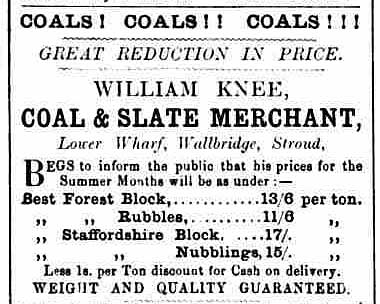

After the adjoining Thames & Severn Canal had opened, Wallbridge Basin became known as the Lower Wharf, Wallbridge, to distinguish it from the wharves on the higher level of the Thames & Severn Canal at Wallbridge. Being close to the centre of Stroud, Wallbridge saw much activity, including barge building at the basin, which began when the Thames and Severn Canal Company built some of their barges there before establishing their yard at the Bourne.
The Lower Wharf at Wallbridge and the nearby Ship Inn was leased by William Knee senior from the middle years of the nineteenth century. From there he supplied building materials, coals imported from the Forest of Dean, Newport and Cardiff, and stone imported from Bristol and Chepstow. He also ran a regular carrying service between Stroud and Bristol.
Operating from the centre of Stroud with fewer vessels than some of their competitors, the Knee’s business survived the decline in the canal’s fortunes, and on occasions profited from the collapse of rival businesses. In 1861, they were able to purchase from James Nurse, at a favourable price, the new Stroud built barge Lewis. The withdrawal of George Nurse senior from the canal trade enabled the Knees’ to introduce a regular fortnightly service between Stroud and Bristol in April 1869, using the barge Mary Louisa, built at Framilode by Benjamin Gardiner for Amos Field of Saul. Following the bankruptcy of John George, they purchased the Brimscombe built barge Maltster, owned and built by George in 1843. On 6th March 1870, Thomas Drinkwater of Stonehouse was master of the Maltster when he met his death by drowning. Whilst sailing down the River Severn to Cardiff during a storm, he was knocked overboard by the main sheet and it was not until the beginning of July that his body was recovered from near Berkeley Pill.
The Dudbridge Wharf tenancy that had been occupied by George Nurse was briefly taken over in 1868 by William Knee, who placed his son William junior in charge at Dudbridge.
The death of William Knee senior in 1876 nearly brought about the collapse of their business, and William junior was forced to sell off a lot of their assets, including a number of barges. However, he continued trading and in September 1889 he took delivery of the sloop rigged barge Sea Breeze, a new vessel built for him at Brimscombe. The following month, in partnership with William Hayward of Cainscross, he also purchased the trow Gertrude (built at Saul in 1875 by Frederick Evans). Unfortunately, the revival of Knee’s business was not sustained and both vessels were subsequently sold to Bristol coal merchant William Galbraith.
By Nigel Harris
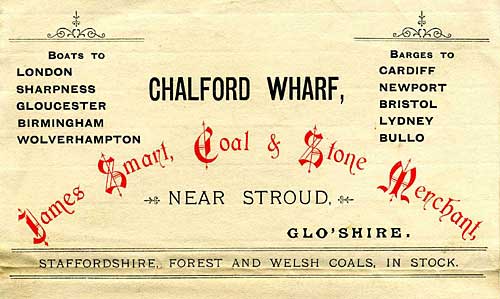

Two carriers who operated from Chalford on the Thames & Severn Canal to ports in the upper Bristol Channel were James Smart and Thomas Henry Pearce. Principally trading as a coal and stone merchant, James Smart owned a number of canal narrow boats and sailing barges, and later operated a road haulage business from his premises on Chalford Wharf. As a young lad, the drink related drowning of his boatman father had a profound effect on him; he never drank and was later to name one of his barges Temperance. Through hard work and guile, James Smart rose from being the master of a Chalford barge to become the principal carrier on the two canals at the end of the nineteenth century and he was also the last owner to have wooden sailing craft built at Brimscombe. Smart had been master of two of his barges that traded outside the limits of the port of Gloucester; the Industry (built at Brimscombe in 1870) and the Perseverance. The Perseverance had traded between Chalford and Bristol with general cargoes until she was lengthened in the 1880s, from which time she only traded on the Stroud canals and River Severn within Gloucester’s port limits. The Industry usually traded to Bristol and Cardiff. In 1883, Smart had the Industry rebuilt and enlarged, and she continued in trade until she was lost in September 1898 when she collided with the Severn Railway Bridge. The small trow Flora was built for Smart at Brimscombe in 1876. Until her loss at the Severn Railway Bridge in July 1894, she regularly traded between Chalford and the Bristol Channel ports. In 1891, James Smart took delivery of a larger Brimscombe built barge, the Excelsior. Trading to Bullo Pill, Chepstow, Bristol, Newport and Cardiff, she remained in Smart’s ownership until 1899, when she was sold to Chepstow quarryman John Richardson, who was to purchase two more of Smart’s barges. In 1901, Smart sold him the Onward, built at Brimscombe in 1896, and in 1908, Richardson also purchased the Temperance that had been built at Brimscombe for Smart in 1901. Another of James Smart’s vessels, the Gem (built at Brimscombe in 1904), was the last vessel to have been recorded as being built as a trow. Her working life under sail was comparatively very short. Having traded from Chalford as far as Cardiff, she was laid up at Stroud in 1911 and later sold for use as a lighter in Bristol Docks.
Thomas Henry Pearce had been owner/master of the barge Reform before owning a succession of vessels, which included the Annie Maria, Dora, Finis, Mystery and Sarah. As well as trading regularly between Chalford and Bristol, Pearce’s vessels traded wherever employment could be found. They carried stone from Chepstow for the repair of the River Severn’s sea walls, coal from Bullo Pill and Lydney to the Stroud canals (when they were manned by casual labour known as hobblers). They also traded as colliers to ports east of the Holmes and at times were also used as lighters on the Gloucester and Berkeley Canal. The Annie Maria traded with coal from Lydney as far as Bridgwater. In March 1876, her master William Griffin of Framilode and his crew were saved when she capsized off Avonmouth whilst bound from Lydney to Bristol. After being towed into the River Avon and placed on the Swash Bank, she was righted and later put back into service. The Stroudwater Barge Finis was built at Brimscombe for Thomas Henry Pearce in 1881. Initially, she carried mainly stone from Bristol and Chepstow before being used in the Bullo Pill coal trade, when she is recorded as having traded along the Thames & Severn Canal as far as Cirencester. Laid up in 1893, she was subsequently sold to Frederick Wood of Westbury on Severn.
By Nigel Harris
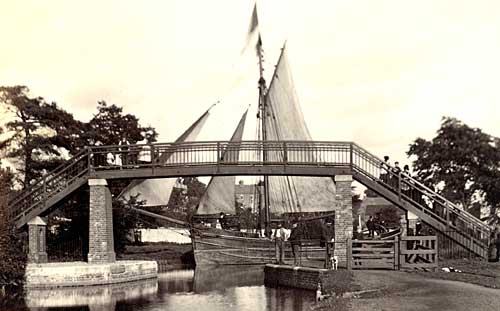

Prominent amongst the corn millers who operated mills along the Stroudwater Canal was John Biddle. Besides his involvement with the Bristol market trade, he also owned vessels that were used to carry corn and flour. His warehouse at Gloucester Docks received imported corn that was shipped, via the Gloucester and Berkeley Canal, to his mills on the Stroudwater Canal at Stratford, Ebley and Wallbridge, and he had an extensive trade between his mills and Bristol. Biddle’s vessels in the corn and flour trade included the barges Avon (built at Tewkesbury in 1834), the Defence (built at Stourport in 1823), the John (built at Lydney in 1843) and the Longney (built at Stroud in 1854). Following Biddle’s death in 1863, the Longney was auctioned at the Ship Inn and purchased by owners at Bristol, who re-registered her there in 1865.
John Biddle’s residence, Stratford Abbey with its extensive grounds and gardens, was near his main milling business at Stratford Mills. Situated on the Painswick Stream, one of the Stroudwater Canal’s main feeders, the mills worked 23 pairs of grind stones; some water powered, but the majority were powered by steam. The higher part of the Stratford Mills site had a railway siding that connected with the Great Western Railway network, and the lower part connected with the Stroudwater Canal. Waterborne cargoes consigned to the mills were transhipped into small boats on the Stroudwater Canal which were then hauled, with the aid of a flash lock, along the Painswick Stream to the mills. After the death of John Biddle, the site was run by corn merchant William Lane. Later, the Stratford Flour Mill Company Limited was formed to lease and operate the mills. However, the company went into liquidation in 1873 and its barges, the Avon (previously owned by Biddle), the Effort (built at Stroud in 1856), and the Wherry Packet (built at Benthall, Shropshire in 1835) were sold off. Stratford Mills was then acquired by the firm of Samuel Butt, of Cainscross, and Francis Skurray, of Faringdon, Oxon, who were operating a corn mill at nearby Cainscross.
Butt and Skurray also operated barges. Those trading to their Cainscross Mill were loaded and discharged on Dudbridge Wharf. In celebration of Samuel Butt’s marriage at Cainscross in October 1865, all the vessels moored at the wharf flew flags and bunting. In December 1875, Butt and Skurray defended an action in the Admiralty Court brought against them by the owners of the steam paddle tug Ranger, (Hartley Hodder, James Calway and John Calway). The tug owners and crew were seeking compensation for salvage services rendered to the millers barge Ceres (built at Gloucester in 1868). On 18th November, the Ceres was lying in Kingroad loaded with corn, having left Bristol the previous day bound for the Stroudwater Canal. Shortly after weighing anchor, the barge lost her tiller and became unmanageable. In the strong westerly gale that was blowing, she drifted broadside to nearby Dumball Island, where she was spotted by the crew of the Ranger, apparently flying a distress signal and with seas breaking over her. With some difficulty, Alexander Everett (master of the Ranger) manoeuvred his tug close by the Ceres, whose crew requested a tow. After three attempts, a line was got aboard the barge and she was towed into deeper water, where her crew attempted to repair their broken tiller. However, Joseph Mabbett of Saul (who was in charge of the barge) found her to be still unmanageable and requested a tow to Sharpness, which the Ranger duly provided. In court, the tug owners and crew sought to recover £150 for salvaging the barge and her cargo, which were valued at £200 and £780 respectively. Having paid £10 for the tow to Sharpness, Butt and Skurray denied the salvage claim, arguing that the flying of the Ceres burgee was not a distress signal, but only indicated that she required a tow as she was not aground or in danger and there had been no risk to the tug. In response, the tug owners pointed out that it was very unusual for vessels such as the Ceres to require the services of a tug. Having decided that the Ranger was instrumental in saving the Ceres and her cargo and taking into account the generous £10 paid for the tow, the court awarded the claimants £50 and their costs.
On the Stroudwater Canal, at Ryeford, Messrs Ford Brothers operated Ryeford Corn and Saw Mills. Established in the 1850s, the business owned a number of vessels until they were disposed of in 1889. Originally there were five brothers involved with the family firm, but following a bitter dispute that culminated in 1878 with a court action, the concern was run by George and Aaron Ford. The mills had their own canal wharf and were also served by a Midland Railway siding. Part of the canal-side site was the scene of some devastation on 8th February 1870, when a six storied stone-built grain warehouse suddenly collapsed. Much of the building and its contents of five thousand sacks of grain fell into the canal. The deluge of debris caused a large wave to sweep across the canal and smash the lower windows of the house on the opposite bank, occupied by George Ford. The warehouse, which had been built about ten years previously, was reduced to a pile of rubble, which was estimated as being thirty feet high and one hundred feet square. Making sustained efforts, the canal company drained the affected stretch and removed the rubble, making the canal navigable again in just over twenty-four hours.
Originally, three of the Ford Brothers (George, Aaron and Samuel) were involved with ownership of the firm’s vessels, which included the lighter Emily, named after George Ford’s daughter, and the trows Caroline, Florence and George, which were built and launched into the Stroudwater Canal at a yard adjacent to their mills in 1855, 1861 and 1873 respectively. The firm also owned a small steamer, the Queen Esther. Ford’s trows traded principally between Ryeford Mills and Bristol carrying grain and flour, and on occasions returning with stone loaded in the Avon Gorge, and to Newport with flour, returning from there with coal.